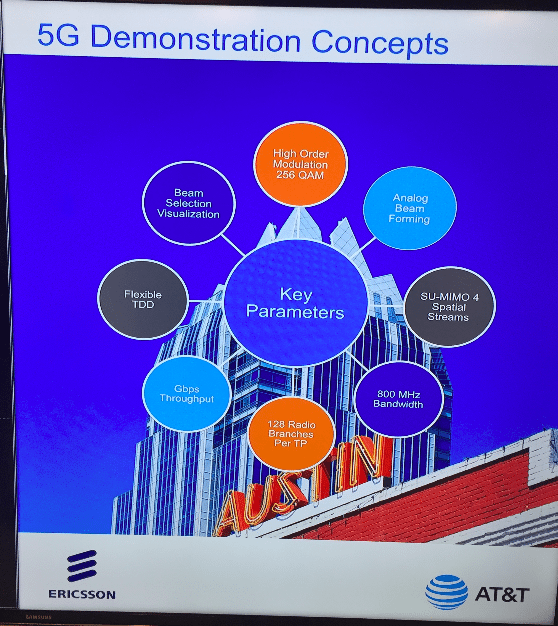AUSTIN, Texas – AT&T and Ericsson unveiled their “5G” millimeter wave network technology today at the Texas Wireless Summit. The companies demonstrated an eight-carrier single-user multiple-input/multiple-output system capable of gigabit per second throughput.
The demonstration included one base station, two radios and one end-user device. Each radio had 64 antenna elements in a horizontal plane and 64 antenna elements in a vertical plane, for a total of 256 antenna streams. The system used analog beamforming, and Ericsson did not map each antenna stream to a separate beam. The demonstration showed 48 beams.
AT&T said that every two milliseconds the radios scan the 48 beams and make the best possible connection. For this demonstration, both radios attached to the same beam, but AT&T said that with multiple user devices the radios would use different beams. During the demo, the radios did not transition from one beam to another very often because the end-user device was stationery.
Tests of this system have shown peak speeds of up to 14 gigabits per second, AT&T said. For this test, one of the eight carriers was used to stream high-definition video, which showed no lags or buffering.
AT&T and Ericsson are using flexible time division duplexing, meaning that the capacity split between the uplink and the downlink can vary. Although LTE in the U.S. relies heavily on frequency division duplexing, flexible test-driven development is expected to play a major role in 5G.
“Our 5G lab trials with Ericsson have shown great results,” said Dave Wolter, AT&T assistant VP for radio technology, in a statement. “As we progress, we hope to continue to accelerate industry standards.”
AT&T said it has structured its demo and its 5G trials with the goal of contributing to the international 5G standards development and pivoting to compliant commercial deployments once standards are set by 3GPP. The carrier foresees multigigabit wireless speeds 10-100 times faster than today’s average 4G LTE wireless connections.
Follow me on Twitter.

